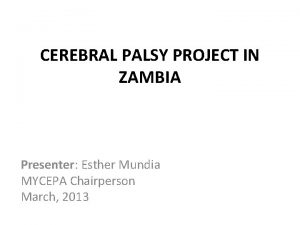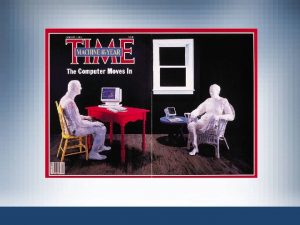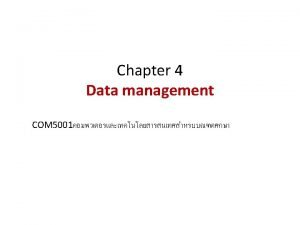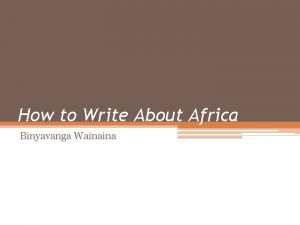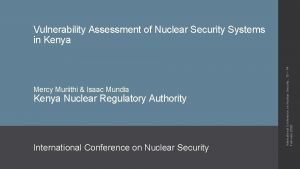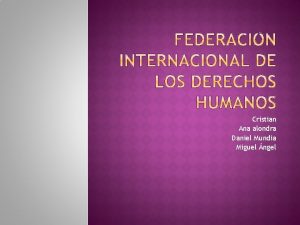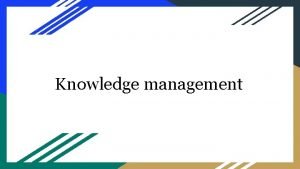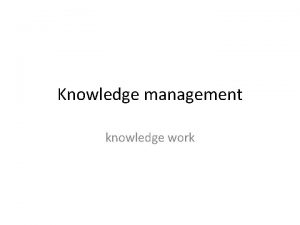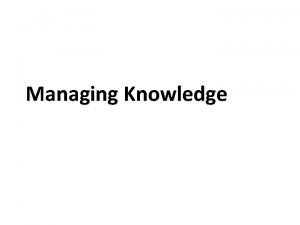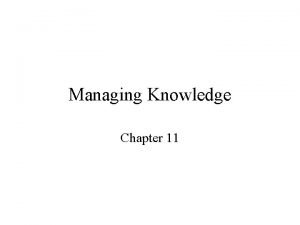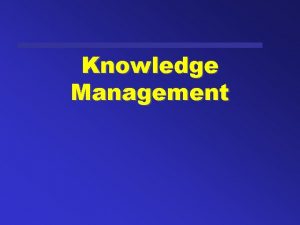Information and Knowledge Management MUNDIA WAINAINA Knowledge Knowledge











- Slides: 11

Information and Knowledge Management MUNDIA WAINAINA

Knowledge § Knowledge is the human expertise stored in a person’s mind gained through experience, understanding, and interaction with the person’s environment. § It is subjective depending on a number of factors e. g. culture, beliefs, values, insights, intuitions and emotions of individuals § Tacit knowledge- Form of knowledge that is subconsciously understood and applied, hard to articulate, developed from direct experience and action and shared through highly interactive conversation § Explicit knowledge- – easy to articulate, capture and distribute in different formats since it is formal and systematic

KM & OL �KM is the identification, growth and effective application of an organization’s critical knowledge, where everyone in the organization creates and shares knowledge which in turn fuel the organization’s innovative strategy �OL focuses on the process while KM focuses on the content of the knowledge that the organization acquires, creates, processes and eventually uses �OL is viewed as the goal of KM. By motivating the creation, dissemination and application of knowledge , KM will pay off by helping the organization embed knowledge into organizational processes so as to continuously improve its practices and behaviors and pursue the achievement of the organizational goals

Knowledge management and organizational learning

KM Process Cycle �KM processes directly improve organizational processes such as innovation, collaborative decisionmaking, individual and collective learning �The improved organizational processes produce intermediate outcomes such as better decisions, organizational behaviours, products, services and relationships �These, in turn, lead to improved organizational performance

Process Cycle Model of KM

Proposed Framework § A holistic approach to managing information and knowledge is proposed. This will include the external factors § Proposed framework consists of three main interlinked sub systems - KM of the organization - KM of the people -KM of the infrastructure and processes § FHOK needs to achieve a balance between the three subsystems in order to achieve a successful km effort § This model is holistic and embraces the importance of aligning the km strategy of FHOK to the overall business strategy of the organization § The organization culture and managing the culture change during implementation is crucial § Focus will also be on FHOK employees and their contribution towards a successful km effort so as to feel part of the change when implementing km § Encourage Individual learning and innovative thinking and possibly reward those that produce quality results § The infrastructure and business processes will encourage the employees to share and disseminate knowledge through out FHOK

Framework

KM Implementation Strategies �KM strategy aims at supplying the organization with the knowledge resources needed to carry out its vision and goals thus the strategy must be closely aligned to the overall organization strategy as a whole. �A KM strategy expresses the overall approach an organization intends to take to align its knowledge resources and capabilities to the intellectual requirements of its strategy. The strategy will provide the framework within which the organization manages new initiatives aimed at leveraging the intangible assets of the organization. (KM is an asset) �The strategy outlines the processes, tools and infrastructure required for knowledge to flow effectively

Conclusion �KM is a set of relatively new organizational activities that are aimed at improving knowledge, knowledge-related practices, organization culture, decisions and organizational performance. KM focuses on knowledge processes-knowledge creation, acquisition, refinement, storage, transfer, sharing and utilization. These processes support organizational processes involving innovation, individual learning, collective learning and collaborative decision-making. These lead to Improved organizational behavior, decisions…… and overall work performance.

THANK YOU
 Mycepa
Mycepa Knowledge management and specialized information systems
Knowledge management and specialized information systems The difference between data information and knowledge
The difference between data information and knowledge Knowledge creation and knowledge architecture
Knowledge creation and knowledge architecture Top management middle management first line management
Top management middle management first line management Management pyramid
Management pyramid Top level management
Top level management Personal vs shared knowledge
Personal vs shared knowledge Knowledge shared is knowledge squared meaning
Knowledge shared is knowledge squared meaning Knowledge shared is knowledge multiplied
Knowledge shared is knowledge multiplied Contoh shallow knowledge dan deep knowledge
Contoh shallow knowledge dan deep knowledge Posteriori knowledge meaning
Posteriori knowledge meaning
